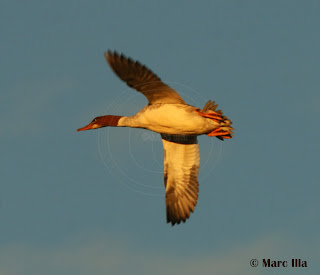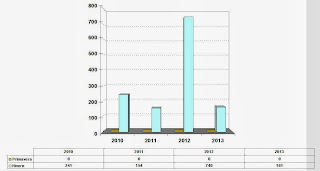Last year I did a 'Top 5 birding moments' in 2012, and although it was difficult to 'choose' last year, I wanted to do it again in 2013. As I said, last year was difficult, but this year have been even more. I should do a 'Top 20' or something like this to be a bit happy with my choise, because yeah, 2013 have been a crazy year for me!
I'll try to resume a bit of everything in a 'Top 5':
5- Eastern species influx
Between 26 and 30th April, a big squall caused a rain of eastern species in Catalonia. Under the rain, I saw 2 Pallid Harriers (Circus macrourus). Also, an Icterine Warbler (Hippolais icterina), a Short-eared Owl (Asio flammeus), lots of Wood Warblers (Phylloscopus sibilatrix) and some other nice migrating species: Ruff, Wood Sandpiper, Grasshopper Warbler, Northern Shoveler, Purple Heron, Black-winged Stilt, Osprey, Black Tern, Greater Short-toed Lark, Montagu's Harriers... all of them in my local patch!

4- 'My own rings'
Last year, December 2012, I finally obtained my 'A license' as a ringer. During my first year, I've trapped and ringed 1683 birds about 80 species with 'my own rings', and I guess I've ring about 5000 birds in total this year! Besides my ringing projects, I've participated in 5 ringing campaigs: Yasmina (Morocco), Menorca (Balearic Islands) and Aiguamolls de l'Empordà (Catalonia) in spring and Falsterbo fågelstation (Sweden) and Ebre Delta (Catalonia) in autumn.

3- Strong feelings
As I said, it has been hard to decide just 5 moments for this year. This one, number 3, should be a shared in two experiences that made me feel strong feelings. The first one was the Red Deer's bellows show, specially when I was surrounded by some males, bellowing and fighting between them. That was really amazing!
But I cannot forget what I experienced just some days ago, in Gallocanta, when 50000 Cranes came, flying and calling, to roost in the lagoon...

2- Bald Ibis
Between March and April I went to Morocco two weeks. I'll never forget a lot of things about that trip...During the first week I was ringing in Yasmina, an oasis. As special birds, we trapped 2 White-crowned Wheatears (Oenanthe leucopyga), a Rufous-tailed Scrub Robin (Cercotrichas galactotes), a Trumpeter Finch (Bucanetes githagineus), a Laughing Dove (Streptopelia senegalensis), some Saharan Olivaceus Warblers (Hippolais pallida reiseri), and the best for me: a cracking male Seebohm's Wheatear (Oenanthe seebohmi). During the second week, we did a tour around the country and we saw almost all species we could expect. Temminck's Larks, Thick-billed Lark, Desert Sparrow, Black-bellied Sandgrouse, Spotted Sandgrouse, Greater Hoopoe-Lark, Rock Martin, Moussier's Redstart, Desert Warbler, Tristram's Warbler, Crimson-winged Finch.... but I'll never forget when my first Bald Ibis (Geronticus eremita), a flock of 4 to be precise, flew over me. I had been walking around a long beach for more than one hour, with the sun burning my skin, and suddenly I saw a distinct shadow passing by...

1- Falsterbo
The time I spend in Falsterbo in summer/autumn was really important for me. There, I learned a lot about everything and I grew up as a birder, as a ringer, as a scientist and also as a person. I'll never forget all that people, that I hope I can meet again!, and specially the Flommen Team, that made everything possible. Thank you again guys!!

Best wishes for 2014! Something make me think it will be another very special year.
Gott Nytt år!
I'll try to resume a bit of everything in a 'Top 5':
5- Eastern species influx
Between 26 and 30th April, a big squall caused a rain of eastern species in Catalonia. Under the rain, I saw 2 Pallid Harriers (Circus macrourus). Also, an Icterine Warbler (Hippolais icterina), a Short-eared Owl (Asio flammeus), lots of Wood Warblers (Phylloscopus sibilatrix) and some other nice migrating species: Ruff, Wood Sandpiper, Grasshopper Warbler, Northern Shoveler, Purple Heron, Black-winged Stilt, Osprey, Black Tern, Greater Short-toed Lark, Montagu's Harriers... all of them in my local patch!

4- 'My own rings'
Last year, December 2012, I finally obtained my 'A license' as a ringer. During my first year, I've trapped and ringed 1683 birds about 80 species with 'my own rings', and I guess I've ring about 5000 birds in total this year! Besides my ringing projects, I've participated in 5 ringing campaigs: Yasmina (Morocco), Menorca (Balearic Islands) and Aiguamolls de l'Empordà (Catalonia) in spring and Falsterbo fågelstation (Sweden) and Ebre Delta (Catalonia) in autumn.

3- Strong feelings
As I said, it has been hard to decide just 5 moments for this year. This one, number 3, should be a shared in two experiences that made me feel strong feelings. The first one was the Red Deer's bellows show, specially when I was surrounded by some males, bellowing and fighting between them. That was really amazing!
But I cannot forget what I experienced just some days ago, in Gallocanta, when 50000 Cranes came, flying and calling, to roost in the lagoon...

2- Bald Ibis
Between March and April I went to Morocco two weeks. I'll never forget a lot of things about that trip...During the first week I was ringing in Yasmina, an oasis. As special birds, we trapped 2 White-crowned Wheatears (Oenanthe leucopyga), a Rufous-tailed Scrub Robin (Cercotrichas galactotes), a Trumpeter Finch (Bucanetes githagineus), a Laughing Dove (Streptopelia senegalensis), some Saharan Olivaceus Warblers (Hippolais pallida reiseri), and the best for me: a cracking male Seebohm's Wheatear (Oenanthe seebohmi). During the second week, we did a tour around the country and we saw almost all species we could expect. Temminck's Larks, Thick-billed Lark, Desert Sparrow, Black-bellied Sandgrouse, Spotted Sandgrouse, Greater Hoopoe-Lark, Rock Martin, Moussier's Redstart, Desert Warbler, Tristram's Warbler, Crimson-winged Finch.... but I'll never forget when my first Bald Ibis (Geronticus eremita), a flock of 4 to be precise, flew over me. I had been walking around a long beach for more than one hour, with the sun burning my skin, and suddenly I saw a distinct shadow passing by...

1- Falsterbo
The time I spend in Falsterbo in summer/autumn was really important for me. There, I learned a lot about everything and I grew up as a birder, as a ringer, as a scientist and also as a person. I'll never forget all that people, that I hope I can meet again!, and specially the Flommen Team, that made everything possible. Thank you again guys!!

Best wishes for 2014! Something make me think it will be another very special year.
Gott Nytt år!




















































